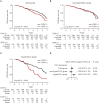Clonal hematopoiesis as a novel risk factor for type 2 diabetes mellitus in patients with hypercholesterolemia
- PMID: 37457265
- PMCID: PMC10345505
- DOI: 10.3389/fpubh.2023.1181879
Clonal hematopoiesis as a novel risk factor for type 2 diabetes mellitus in patients with hypercholesterolemia
Abstract
Introduction: Clonal hematopoiesis of indeterminate potential (CHIP) is associated with atherosclerosis and cardiovascular disease. It has been suggested that CHIP may be related to diabetes, so we investigated the association between CHIP and new-onset type 2 diabetes.
Methods: This study included 4,047 subjects aged >=40 years without diabetes. To detect CHIP, targeted gene sequencing of genomic DNA from peripheral blood cells was performed. The incidence of new-onset type 2 diabetes during the follow-up period was evaluated.
Results: Of the total subjects, 635 (15.7%) had CHIP. During the median follow-up of 5.1 years, the incidence of new-onset diabetes was significantly higher in CHIP carriers than in subjects without CHIP (11.8% vs. 9.1%, p = 0.039). In a univariate analysis, CHIP significantly increased the risk of new-onset diabetes (HR 1.32, 95% CI 1.02-1.70, p = 0.034), but in a multivariate analysis, it was not significant. The CHIP-related risk of new onset diabetes differed according to LDL cholesterol level. In the hyper-LDL cholesterolemia group, CHIP significantly increased the risk of diabetes (HR 1.64, 95% CI 1.09-2.47, p = 0.018), but it did not increase the risk in the non-hyper-LDL cholesterolemia group. The subjects with CHIP and hyper-LDL-cholesterolemia had approximately twice the risk of diabetes than subjects without CHIP and with low LDL cholesterol (HR 2.05, 95% CI 1.40-3.00, p < 0.001).
Conclusion: The presence of CHIP was a significant risk factor for new-onset type 2 diabetes, especially in subjects with high LDL cholesterol. These results show the synergism between CHIP and high LDL cholesterol as a high-risk factor for diabetes.
Keywords: LDL cholesterol; clonal hematopoiesis; diabetes mellitus; hematopoiesis; hypercholesterolemia.
Copyright © 2023 Kim, Song, Koh, Lee, Park, Choi, Yoon and Choi.
Conflict of interest statement
HS and YK are shareholders of Genome Opinion, Inc. The content of this study has been applied as a patent by HS and S-YC. The remaining authors declare that the research was conducted in the absence of any commercial or financial relationships that could be construed as a potential conflict of interest.
Figures

Similar articles
-
Impact of clonal haematopoiesis on atherosclerotic cardiovascular disease according to low-density lipoprotein cholesterol levels in general population.Eur J Prev Cardiol. 2024 Jul 23;31(9):1162-1171. doi: 10.1093/eurjpc/zwae055. Eur J Prev Cardiol. 2024. PMID: 38349357
-
Associations between serum cholinesterase and incident hyper-LDL cholesterolemia, hypertriglyceridemia and hypo-HDL cholesterolemia as well as changes in lipid levels in a health screening population.Atherosclerosis. 2015 Jul;241(1):1-5. doi: 10.1016/j.atherosclerosis.2015.04.804. Epub 2015 Apr 26. Atherosclerosis. 2015. PMID: 25935113
-
Relationship Between Risk of Hyper-Low-density Lipoprotein Cholesterolemia and Evacuation After the Great East Japan Earthquake.J Epidemiol. 2022 Jun 5;32(6):277-282. doi: 10.2188/jea.JE20200267. Epub 2021 Jun 22. J Epidemiol. 2022. PMID: 33441506 Free PMC article.
-
A new risk factor associated with cardiovascular disease: clonal hematopoiesis of indeterminate potential.Mol Biol Rep. 2023 Mar;50(3):2813-2822. doi: 10.1007/s11033-022-08118-1. Epub 2023 Jan 3. Mol Biol Rep. 2023. PMID: 36595120 Review.
-
Interplay between Clonal Hematopoiesis of Indeterminate Potential and Metabolism.Trends Endocrinol Metab. 2020 Jul;31(7):525-535. doi: 10.1016/j.tem.2020.02.005. Epub 2020 Mar 3. Trends Endocrinol Metab. 2020. PMID: 32521236 Review.
Cited by
-
Regulators of clonal hematopoiesis and physiological consequences of this condition.J Cardiovasc Aging. 2024 Jan;4(1):3. doi: 10.20517/jca.2023.39. Epub 2023 Dec 31. J Cardiovasc Aging. 2024. PMID: 39119355 Free PMC article.
-
Clonal hematopoiesis in AML long-term survivors: Risk factors and clinical consequences.Hemasphere. 2025 Jul 24;9(7):e70183. doi: 10.1002/hem3.70183. eCollection 2025 Jul. Hemasphere. 2025. PMID: 40709316 Free PMC article.
-
Clonal haematopoiesis of indeterminate potential: an emerging risk factor for type 2 diabetes and related complications.Diabetologia. 2025 May;68(5):920-929. doi: 10.1007/s00125-025-06393-8. Epub 2025 Mar 10. Diabetologia. 2025. PMID: 40064675 Review.
-
Targeting cholesterol-driven pyroptosis: a promising strategy for the prevention and treatment of atherosclerosis.Mol Biol Rep. 2025 May 15;52(1):459. doi: 10.1007/s11033-025-10554-8. Mol Biol Rep. 2025. PMID: 40372511 Review.
-
Clonal Hematopoiesis of Indeterminate Potential (CHIP) and Incident Type 2 Diabetes Risk.Diabetes Care. 2023 Nov 1;46(11):1978-1985. doi: 10.2337/dc23-0805. Diabetes Care. 2023. PMID: 37756531 Free PMC article.
References
-
- American Diabetes Association Professional Practice C, American Diabetes Association Professional Practice C, Draznin B, Aroda VR, Bakris G, Benson G, et al. . 2. Classification and diagnosis of diabetes: standards of medical care in diabetes-2022. Diabetes Care. (2022) 45:S17–38. 10.2337/dc22-S002 - DOI - PubMed
Publication types
MeSH terms
Substances
LinkOut - more resources
Full Text Sources
Medical

